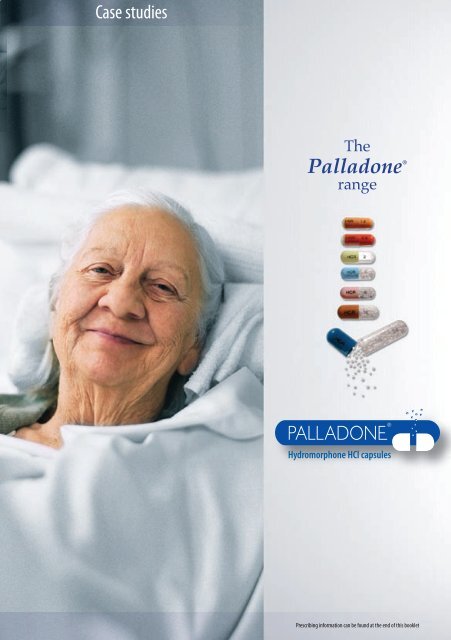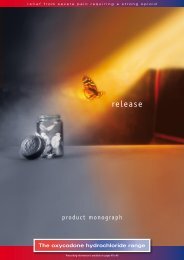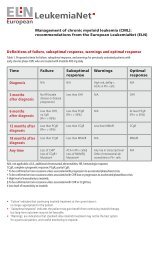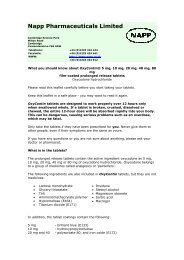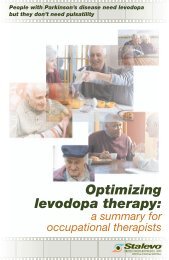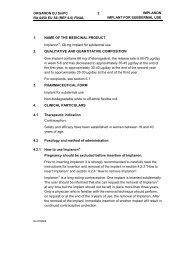3365 Pall case study booklet v5.indd - epgonline.org
3365 Pall case study booklet v5.indd - epgonline.org
3365 Pall case study booklet v5.indd - epgonline.org
- No tags were found...
You also want an ePaper? Increase the reach of your titles
YUMPU automatically turns print PDFs into web optimized ePapers that Google loves.
Case studiesCase 3renal carcinomaH, a 56-year-old man with renal carcinoma, and lung and bone metastases,was referred to a hospice with a long history of severe and incapacitating painin his right hip. Radiotherapy, pamidronate and local steroid injections had failedto relieve the pain, which seemed to be bony in origin, but also had a neuropathiccomponent. The pain was disturbing H’s sleep and preventing him from working.H was taking tramadol 100 mg four times daily and diclofenac 50 mg threetimes daily. He was experiencing indigestion, so the hospice withdrew thediclofenac, and started gabapentin and oral steroids. The steroids relievedthe pain, but rapidly led to weight gain and oedema. H asked to discontinuethe steroids because of toxicity. The hospice withdrew the tramadoland started treatment with methadone, but at doses above 15 mg/day,H became drowsy and hallucinated. He was switched to <strong>Pall</strong>adone SR capsulesand, at a dose of 8 mg 12-hourly with 2.6 mg <strong>Pall</strong>adone capsules at night,his pain was stable with minimal side effects.Case 4pancreatic cancerJ, a 73-year-old man with pancreatic cancer and liver metastases, had severeabdominal pain following surgery for his pancreatic cancer. Analgesics fromStep 2 of the World Health Organization analgesic ladder were not adequate,so J was prescribed fentanyl patches. A 25 µg/h patch alleviated the pain slightly,but J experienced considerable side effects, including nausea, dizziness andconstipation. J was switched to <strong>Pall</strong>adone SR capsules 4 mg 12-hourly, whichprovided complete pain relief with no side effects. J did not need any analgesiafor breakthrough pain and, having previously been unable to walk 300 mto the supermarket, he was now able to take a holiday with his family.<strong>3365</strong> <strong>Pall</strong> <strong>case</strong> <strong>study</strong> <strong>booklet</strong> <strong>v5.indd</strong> 6 14/9/05 12:56:59 pm
Opioid switchingCase 5head and neck cancerD, a 50-year-old man with head and neck cancer, had severe ear pain due tohis tumour. He was started on morphine, but was very sleepy and was thereforeswitched to oxycodone. His condition improved for several weeks, but whenthe oxycodone dose was rapidly increased due to severe pain, the problemof sleepiness returned. He was switched to the <strong>Pall</strong>adone range and, despitereceiving a high dose, he was able to communicate effectively with his familybefore his death.Case 6rectal carcinomaE, a 70-year-old man with carcinoma of the rectum, was referred to a day hospicewith opioid-sensitive severe rectal pain. He was initially treated with 40 mg ofmorphine 4-hourly. This relieved the pain, but E also experienced nausea andconstipation, and occasionally f<strong>org</strong>ot to take his medication. He was switchedto fentanyl patches and continued to take 40 mg immediate release morphinefor breakthrough pain. However, he often found his analgesia insufficient andan increase in his morphine dose to 60 mg led to unacceptable side effects.Switching E to oxycodone was unsuccessful, so he was given transmucosalfentanyl lozenges and his dose was titrated upwards. At a dose of 1 600 µg,E’s pain relief was better than with morphine, but his pain often returned after30 – 40 minutes and he would need to use two lozenges in quick succession.Whilst at home, his oral opioids were increased in an effort to combat theproblem, but he became unwell and was admitted to the hospice.As the duration of his breakthrough pain was too long for transmucosal fentanyl,E was started on <strong>Pall</strong>adone capsules 7.8 mg as required. This gave a moreacceptable balance of analgesia and side effects, and E was discharged homewith both drugs, allowing him to choose between them depending on thequality and severity of the breakthrough pain he experienced.<strong>3365</strong> <strong>Pall</strong> <strong>case</strong> <strong>study</strong> <strong>booklet</strong> <strong>v5.indd</strong> 7 14/9/05 12:57:03 pm
Unfortunately, whilst at home, he was switched from <strong>Pall</strong>adone capsules tomorphine. This led to recurrence of his side effects and re-admission to the hospice,where <strong>Pall</strong>adone capsules were re-instated. The switch back to <strong>Pall</strong>adone capsulesimproved his symptoms and, once his condition was stable again, he returned homeand continues to use a combination of <strong>Pall</strong>adone capsules and transmucosal fentanyl.Case 7oesophageal cancerS was a mother of two in her thirties with oesophageal cancer. She had initially beentreated with morphine, but she experienced sedation and hallucinations. Switchingto oxycodone solved the problems, but as her cancer became more aggressive and herpain increased, the increased doses of oxycodone led to drowsiness, confusion andhallucinations. In addition to the side effects, S was starting to find swallowing difficult.S was switched to the <strong>Pall</strong>adone range, which allowed her to open the capsules andsprinkle the contents onto her food. Her side effects subsided and her pain was broughtunder control. She was able to care for her children and lead a relatively normal life upuntil her death.NB If patients use the option of opening <strong>Pall</strong>adone SR capsules and sprinkling thecontents onto soft, cold food, they must be instructed not to chew or crush the contentsas this will disrupt the prolonged release mechanism and could lead to overdose.Case 8breast cancerB, a woman in her early fifties with breast cancer, was experiencing severe nociceptiveand neuropathic pain with some hand contractures. She was initially treated withmorphine, but within three weeks, she became drowsy and confused. She wasswitched to oxycodone and responded well initially, but within four weeks, shewas again experiencing drowsiness, which she found distressing. She was switchedto <strong>Pall</strong>adone SR capsules. After four weeks on a dose of 10 mg 12-hourly, she hadexcellent pain control with no signs of drowsiness or confusion. B was happy to remainon <strong>Pall</strong>adone SR capsules and staff commented that her quality of life was improved.<strong>3365</strong> <strong>Pall</strong> <strong>case</strong> <strong>study</strong> <strong>booklet</strong> <strong>v5.indd</strong> 8 14/9/05 12:57:07 pm
Renal failure and opioid switchingCase 1multiple myeloma and chronic renal failureL, a 67-year-old man with multiple myeloma and associated chronic renalfailure, had severe neck pain and weakness in both arms. An MRI scan revealedthat there were no deposits or spinal cord compression. L had surgery for carpaltunnel decompression, which gave him some relief, but his neck pain was stilla problem. He was initially prescribed prolonged release morphine 150 mgonce-daily, which gave good pain relief, but L developed hallucinations, andcontinuous nausea and vomiting. He was switched to <strong>Pall</strong>adone SR capsules10 mg 12-hourly with concomitant levomepromazine for the nausea. L’s paincontrol improved and he had no hallucinations. His pain was controlled untilhis death six weeks later.Case 2renal cell carcinomaM, a 68-year-old man with renal cell carcinoma, was referred to a day hospicewith severe bone and loin pain. He had never tolerated morphine, so he wasinitially prescribed fentanyl patches and immediate release oxycodone, whichcontrolled his pain. However, the patches were failing to adhere properly,so M was switched to prolonged release oxycodone, which was also effective.Although his pain control remained stable for several months, he eventuallybecame drowsy, and he experienced tremors and vivid dreams. He wasunwilling to receive fentanyl patches again, so he was admitted to the hospicefor close monitoring while alfentanil was started. Within 48 hours of receivings.c. alfentanil, his side effects improved. He was happy to use a syringe driver,but this route of administration is not appropriate for providing breakthroughmedication. M refused to receive transmucosal fentanyl, so he was prescribed<strong>Pall</strong>adone capsules 7.8 mg as required. By using between two and threedoses per day, M experienced good pain relief with no adverse effects.M was discharged home and, with slight increases in his dose over the nextthree weeks, he remained pain-free until his death two months later.<strong>3365</strong> <strong>Pall</strong> <strong>case</strong> <strong>study</strong> <strong>booklet</strong> <strong>v5.indd</strong> 9 14/9/05 12:57:11 pm
Case 3prostate cancerN, a 48-year-old man with adenocarcinoma of the prostate, had been effectivelymaintained on prolonged release morphine. However, when he developed renalimpairment, he began to suffer drowsiness due to accumulation of morphinemetabolites, and prolonged release morphine was also no longer controlling hispain. N was switched to <strong>Pall</strong>adone SR capsules 8 mg 12-hourly and becamemore alert within 24 hours. Over the next week, his dose was titrated to 20 mg12-hourly at which he was pain-free and had no drowsiness. After six weeks,N suffered a kidney infection, during which he needed i.v. antibiotics and i.v.hydromorphone. However, once the infection had cleared, he was re-establishedon his previous dose of <strong>Pall</strong>adone SR capsules. N remained pain-free with<strong>Pall</strong>adone SR capsules for 2.5 years. During this time, despite an increasein dose to 64 mg 12-hourly, N did not suffer drowsiness.Case 4rectal carcinomaP, a 67-year-old man with carcinoma of the rectum, extensive metastasesand bilateral hydronephrosis, was referred for pain control. In addition to renalfailure, P was suffering myoclonus and drowsiness, and was in low spirits.P was receiving prolonged release morphine 50 mg 12-hourly, but he refusedto take immediate release morphine because it increased his drowsiness.P was unsuitable for treatment with an NSAID because of his renal failure,so he was prescribed <strong>Pall</strong>adone SR capsules 2 mg 12-hourly and<strong>Pall</strong>adone capsules 1.3 mg as required. Within two days, P was alert and hismyoclonus had gone. His dose of <strong>Pall</strong>adone SR capsules was titrated overfour days to 6 mg 12-hourly with <strong>Pall</strong>adone capsules 3.9 mg as required.He was discharged home pain-free and able to look after himself, and wasvery happy to be free of the side effects.<strong>3365</strong> <strong>Pall</strong> <strong>case</strong> <strong>study</strong> <strong>booklet</strong> <strong>v5.indd</strong> 10 14/9/05 12:57:14 pm
Renal failure and opioid switchingCase 5bladder carcinomaR, a 75-year-old man with carcinoma of the bladder and liver metastases,was admitted to hospital with increased confusion, severe back pain andhallucinations. He had been receiving prolonged release morphine30 mg 12-hourly plus immediate release morphine 10 – 20 mg as required.Blood test results showed that R had renal impairment. His renal functioncontinued to deteriorate, and he became fidgety and agitated.R was referred to the palliative care team who discontinued his morphineand switched him to <strong>Pall</strong>adone SR capsules 4 mg 12-hourly plus<strong>Pall</strong>adone capsules 1.3 mg as required, and regular paracetamol andlaxatives. The day after the switch, R’s cognitive function was improvedand he was alert. R continued to have good pain control until he wasno longer able to tolerate oral medication.Case 6myelomaS, an 84-year-old man with myeloma, was admitted to a hospice witha history of hip and knee pain. S had been prescribed 30 mg prolongedrelease morphine 12-hourly by his GP, but his pain was not controlledand he had taken immediate release morphine to improve the situation.He was now excessively drowsy and nauseated, and he had lost his mobility.The hospice staff discontinued his morphine and prescribed Co-codamol,but S was in severe pain. Because his blood test results showed signs ofrenal impairment, he was prescribed <strong>Pall</strong>adone capsules 1.3 mg asrequired for breakthrough pain. Over the next few days, S became morealert and his nausea resolved. The haematologist felt that his clinical signsand symptoms were indicative of active myeloma, so S received a 4-daycourse of dexamethasone. With his improved pain control, S became moremobile and was able to return home to his wife, where he continuesto take <strong>Pall</strong>adone capsules for breakthrough pain.<strong>3365</strong> <strong>Pall</strong> <strong>case</strong> <strong>study</strong> <strong>booklet</strong> <strong>v5.indd</strong> 11 14/9/05 12:57:18 pm
A confident choice in severe cancer painHydromorphone HCl capsules<strong>3365</strong> <strong>Pall</strong> <strong>case</strong> <strong>study</strong> <strong>booklet</strong> <strong>v5.indd</strong> 12 14/9/05 12:57:22 pm
Hydromorphone HCl capsulesPresentation:The capsules contain Hydromorphone Hydrochloride USP.<strong>Pall</strong>adone capsules: 1.3 mg - orange/clear marked HNR 1.3; 2.6 mg - red/clear marked HNR 2.6.<strong>Pall</strong>adone SR capsules (prolonged release): 2 mg - yellow/white marked HCR 2;4 mg - pale blue/clear marked HCR 4; 8 mg - pink/clear marked HCR 8;16 mg - brown/clear marked HCR 16; 24 mg - dark blue/clear marked HCR 24.Indications:For the relief of severe pain in cancer.Dosage and administration:The capsules can be swallowed whole or their contents can be sprinkled onto soft cold food.Adults and children over 12 years: The normal starting dose is one <strong>Pall</strong>adone capsule 1.3 mg,4-hourly or, alternatively, one <strong>Pall</strong>adone SR capsule 4 mg, 12-hourly. Increasing severityof pain will require increased dosage of hydromorphone to achieve the desired relief.Elderly and patients with renal impairment: These patients may require a lower dosagethan adults to achieve adequate analgesia.Contra-indications:Respiratory depression, pregnancy and lactation, coma, acute abdomen, hepatic impairment,known hydromorphone sensitivity, concurrent administration of monoamine oxidase inhibitorsor within 2 weeks of discontinuation of their use, raised intracranial pressure or head injury,patients with convulsive disorders or acute alcoholism, children under 12 years, pre-operativeuse of the SR capsules.Precautions and warnings:Hypothyroidism, chronic obstructive airways disease, renal or adrenocortical insufficiency,prostatic hypertrophy, shock or reduced respiratory reserve. Hydromorphone is not recommendedin the first 24 hours post-operatively. After this time use with caution, particularly followingabdominal surgery. Do not use where there is the possibility of paralytic ileus occurring.Should paralytic ileus be suspected or occur, hydromorphone should be discontinued.Patients about to undergo cordotomy or other pain relieving surgical procedures should notreceive the SR capsules for 24 hours before surgery, and the normal release capsules for4 hours before surgery. If further treatment with hydromorphone is indicated, the dosageshould be adjusted to the new post-operative requirement.Interactions:Hydromorphone potentiates the effects of tranquillisers, anaesthetics, hypnotics and sedatives.Side-effects:Hydromorphone may cause constipation, nausea and vomiting. Constipation may be treated withappropriate laxatives. When nausea and vomiting are troublesome, hydromorphone can be readilycombined with antiemetics. Tolerance and dependence may occur.Legal category:CD (Sch 2) POM.Package quantities and price:Blister packs of 56 capsules.<strong>Pall</strong>adone capsules 1.3 mg – £8.82<strong>Pall</strong>adone capsules 2.6 mg – £17.64<strong>Pall</strong>adone SR capsules 2 mg – £20.98<strong>Pall</strong>adone SR capsules 4 mg – £28.75<strong>Pall</strong>adone SR capsules 8 mg – £56.08<strong>Pall</strong>adone SR capsules 16 mg – £106.53<strong>Pall</strong>adone SR capsules 24 mg – £159.82Product licence numbers:<strong>Pall</strong>adone capsules 1.3 mg, 2.6 mg – PL 16950/0049 - 0050<strong>Pall</strong>adone SR capsules 2 mg, 4 mg, 8 mg, 16 mg, 24 mg – PL 16950/0051 - 0055Product licence holder:Napp Pharmaceuticals Ltd Cambridge Science Park Milton Road Cambridge CB4 0GW. UKTel: 01223 424444Date of preparation:November 2004<strong>Pall</strong>adone and the Napp device are Registered Trade Marks.® © Napp Pharmaceuticals Limited 2005.Date of preparation: September 2005UK/PA-05014<strong>3365</strong> <strong>Pall</strong> <strong>case</strong> <strong>study</strong> <strong>booklet</strong> <strong>v5.indd</strong> 1 14/9/05 12:56:38 pm


